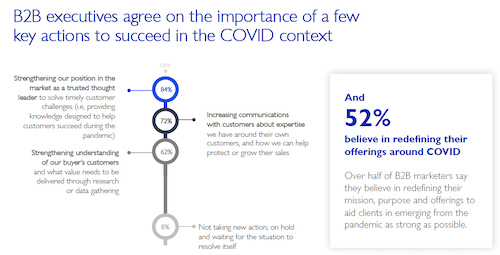Connect the Dots: Creating Demand Through Thought Leadership
Connectivity and collaboration are critical aspects of a full-funnel marketing approach that sets up modern B2B organizations for success.
Just as it is wise to avoid siloed departments and functions in a business operation, it is equally wise to avoid siloed tactics. Too many executives look at branding and demand generation as separate and distinct, when in reality they are interwoven and complementary.
“We need to generate leads right now, so let’s pull our budget from branding and invest there.” It’s an understandable reaction, but unfortunately, can be a self-sabotaging mindset.
To help illustrate this relationship, let’s connect the dots by taking a look at one of the most impactful forms of B2B brand-building — thought leadership — and how it directly affects and improves demand generation.
Thought Leadership Sets the Stage
Before you can generate demand from an audience of decision makers, you first need to get their attention, and engage them with things they care about. Research shared in the 2020 Thought Leadership Impact Study from LinkedIn and Edelman makes a strong case:
- 48% of decision makers spend an hour or more per week engaging with thought leadership
- 89% of decision makers rate thought leadership as effective at enhancing their perceptions of an organization
- 49% of decision makers rate thought leadership as effective at influencing their purchase decisions
- 26% of producers of thought leadership can tie their thought leadership efforts to sales and business win
The attribution issues may come down to prevalent disconnects in measurement, or even in strategy. Is your thought leadership approach built to expressly support your demand and lead generation tactics?
Remember, to succeed as B2B marketers, we must win over hearts and minds. Through strategically aligning thought leadership with demand gen, you address both.
Priming the Rational Mind by Engaging the Emotional Mind
Our Brand and Demand Hub features numerous stats, insights, and resources to help you actualize a full-funnel strategy. One visual you’ll find on the page is this chart, which illustrates the differing effects of brand and demand:
This intuitively makes sense: relationships are built at an emotional level, while key business decisions must ultimately be calculated in nature, and rigorously considered. But that is not to say the two are independent of one another. Trust and credibility built through upper-funnel thought leadership content are very much parts of the rational calculus taking place at the end stage.
In the 2020 Thought Leadership Impact Study, more than half of decision makers said thought leadership was directly influential in increasing the amount of business they did with a company, or leading them to buy a new product or service from a company. Forty-two percent said they’d pay a premium to work with a company that produces thought leadership over one that does not.
The importance of building trust via thought leadership holds additional weight in our current time of uncertainty and widespread disruption. People want information and guidance they can count on, about things that matter to them. It appears this is not lost on business leaders; an Edelman-LinkedIn Pulse Study released in September, discussing how B2B companies are adapting customer engagement strategies during COVID, found that 84% of B2B executives are focused on strengthening their position in the market as a trusted thought leader to solve timely customer challenges. This topped all other answers.
Now more than ever, demand generation techniques simply can’t stand on their own. Branding plays, and especially impactful thought leadership, are critical to building the bridge and making lower-funnel investments pay off.
How to Create Demand through Thought Leadership
It all comes back to synergy, and connecting the two tactics in a harmonious way. Build trust and brand affinity through genuinely helpful thought leadership, and then capitalize later by capturing demand.
One example shared in our Brand to Demand Playbook shows how the HR software company BambooHR used thought leadership and demand generation with a targeted list of accounts to strike the right balance:
After uploading a list of targeted accounts, the BambooHR team was able to build brand awareness through thought leadership. The content centered on key topics of interest to their target audience, such as remote work and culture. For the thought leadership content, Single Image Ads provided high-engagement touchpoints in the LinkedIn feed. Then, to generate leads, the team promoted Message Ads with a single call-to-action. This combination led to higher engagement and conversions from key audiences.
Would those Message Ads have been effective if not for the mindshare and favorable recognition previously earned by the TL-driven awareness campaign? The results suggest probably not. This is the type of scenario that makes the relationship clear and simple to see.
How can you put this kind of holistic strategy into action? Here are a few ideas:
- Share original thought leadership through your company’s LinkedIn Page or an executive’s profile, and then reach out to people who engaged with or commented on the post to advance the conversation.
- Produce a high-quality ungated resource featuring thought leadership content, with a gated follow-up piece available for those who want to dig deeper into the subject.
- Create thematically aligned ad campaigns under the awareness and conversion objectives through LinkedIn’s objective-based advertising.
- Using Website Retargeting, deliver highly specific offers to individuals who visited a page on your website featuring thought leadership on a subject relevant to said offers.
Connect Thought Leadership to Demand Gen for the Full Picture
When your demand generation methods are strategically linked to your upper-funnel branding efforts, they become all the more effective. Recognize the power of valuable thought leadership for building trust and enhancing perception, then use this content to support demand gen.
Therein lies the key to winning hearts and minds.
Subscribe to the LinkedIn Marketing Blog for more content that helps you take the lead.
Related articles








